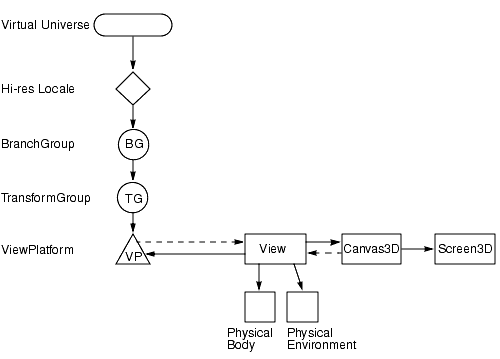
Java 3D is fundamentally a scene graph-based API. Most of the constructs in the API are biased toward retained mode and compiled-retained mode rendering. However, there are some applications that want both the control and the flexibility that immediate-mode rendering offers.
Immediate-mode applications can either use or ignore Java 3D's scene graph structure. By using immediate mode, end-user applications have more freedom, but this freedom comes at the expense of performance. In immediate mode, Java 3D has no high-level information concerning graphical objects or their composition. Because it has minimal global knowledge, Java 3D can perform only localized optimizations on behalf of the application programmer.
Java 3D provides utility functions that create much of this structure on behalf of a pure immediate-mode application, making it less noticeable from the application's perspective-but the structure must exist.
All rendering is done completely under user control. It is necessary for the user to clear the 3D canvas, render all geometry, and swap the buffers. Additionally, rendering the right and left eye for stereo viewing becomes the sole responsibility of the application.
In pure immediate mode, the user must stop the Java 3D
renderer, via
the Canvas3D object stopRenderer()
method, prior to adding the Canvas3D object to an active View object
(that is, one that is attached to a live ViewPlatform object).
The basic Java 3D stereo rendering loop, executed for each Canvas3D, is as follows:
clear canvas (both eyes)
call preRender() // user-supplied method
set left eye view
render opaque scene graph objects
call renderField(FIELD_LEFT) // user-supplied method
render transparent scene graph objects
set right eye view
render opaque scene graph objects again
call renderField(FIELD_RIGHT) // user-supplied method
render transparent scene graph objects again
call postRender() // user-supplied method
synchronize and swap buffers
call postSwap() // user-supplied methodThe basic Java 3D monoscopic rendering loop is as follows:
clear canvas
call preRender() // user-supplied method
set view
render opaque scene graph objects
call renderField(FIELD_ALL) // user-supplied method
render transparent scene graph objects
call postRender() // user-supplied method
synchronize and swap buffers
call postSwap() // user-supplied methodIn both cases, the entire loop, beginning with clearing the canvas and ending with swapping the buffers, defines a frame. The application is given the opportunity to render immediate-mode geometry at any of the clearly identified spots in the rendering loop. A user specifies his or her own rendering methods by extending the Canvas3D class and overriding the
preRender, postRender, postSwap,
and/or renderField methods.